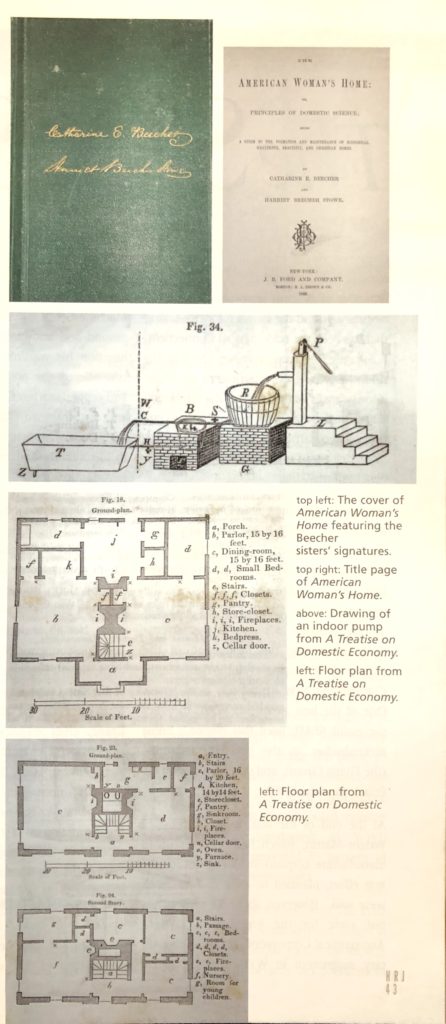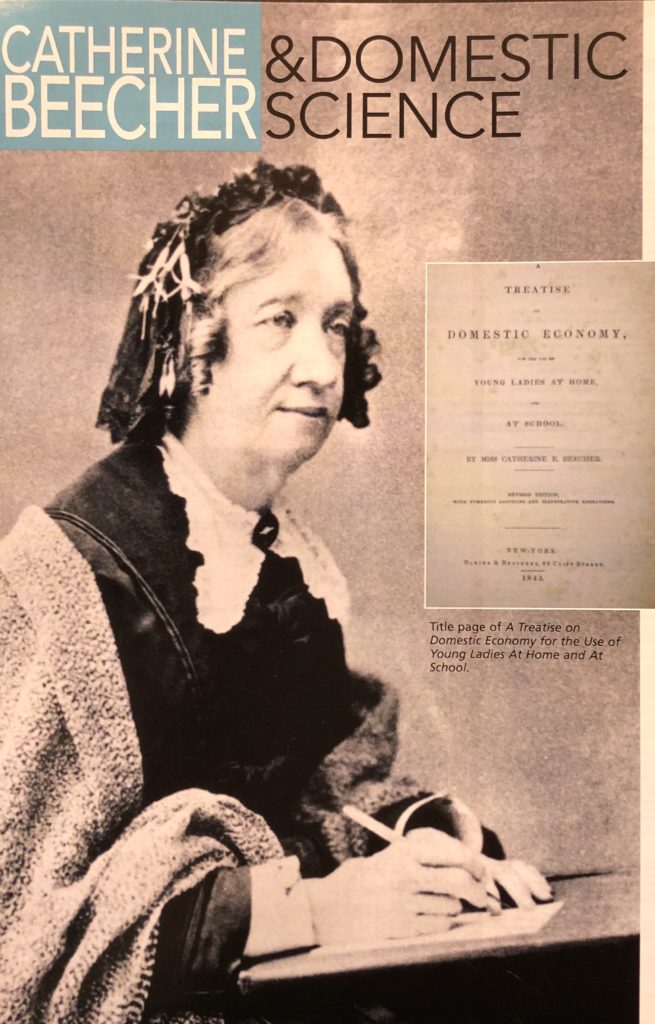(c) Connecticut Explored Inc. Spring 2005
Subscribe/Buy the Issue!
Not all innovation occurs in factories or laboratories. Sometimes innovation, like charity, begins at home. The Beecher family, whose most notable members were innovators of social justice, also advocated new approaches to the design and use of domestic spaces.
When oldest sister Catharine (sometimes spelled Catherine) Beecher (1800 – 1878) published A Treatise on Domestic Economy for the Use of Young Ladies At Home and At School in 1841, she became one of the first Americans to publicly promote a systematic approach to running a household. Beecher’s emphasis on training young women for what she and society then considered their primary roles of wife and mother, makes it easy to dismiss the work as conservative, but Domestic Economy was novel in many ways.
It was the first American domestic advice book to emphasize science as the basis for running a home. The book was reprinted annually over the next three decades and was immensely popular, helping make Catherine Beecher a leading authority on running a home. Domestic Economy recommended ways to integrate and standardize various aspects of domesticity; it covered topics from exercise, health and hygiene, child rearing, and fashion, to economics, horticulture, and architecture. For increasingly well-educated American women it provided new strategies for approaching a traditional role, and a new regard for its importance.
The design of domestic interiors was an important element of Beecher’s work. “There is no point of domestic economy which more seriously involves the health and daily comfort of American women, than the proper construction of houses,” she stated. Domestic Economy argued that the arrangement of rooms and furnishings affected people’s heath, morals, and spiritual well-being, which were within women’s traditional sphere of concern. Beecher was soon at the forefront of a movement that gave women more influence in the design and use of household spaces. “There are five particulars to which attention should be given in building a house,” wrote Beecher, “…economy of labor, economy of money, economy of health, economy of comfort, and good taste.” Her advice may have saved money, but her true concern was the labor, health, and comfort of women. She advocated economical, practical homes for various income levels, and, in a step that took Domestic Economy beyond similar American works, Beecher included floor plans, and illustrated how to improve water, ventilation, and heating systems.

top left: American Woman’s Home featuring the Beecher sisters’ signatures. top right: title page of American Woman’s Home. center top: Drawing of an indoor pump from “A Treatise on Domestic Economy.” center bottom: Floor plan from “A Treatise on Domestic Economy.” bottom: Floor plan from “A Treatise on Domestic Economy. Harriet Beecher Stowe Center
Indoor privies and bathing rooms, central heating, multiple storage closets, and multi-purpose rooms were not luxuries, or even conveniences, declared Beecher, but the means to efficiently manage a household. Running water meant less time carrying water in or back out of the house. Indoor privies would eliminate the necessity of cold dark trips outdoors in the middle of the night, and reduced the need for chamber pots and their cleaning. Indoor bathing facilities meant improved hygiene and general health. Central heating, if done properly, was economical, and helped maintain a family’s health, thus reducing medical expenses and lost productivity.
Beecher freely admitted that many of the ideas in Domestic Economy were not originally hers, and insisted that bringing the latest scientific theories to homemakers helped them do their jobs efficiently. In doing so, Beecher became one of the first Americans to help popularize many of the new approaches to domesticity.
In 1869, Catharine Beecher collaborated with her younger, and by then more famous, sister Harriet Beecher Stowe. Stowe, best known for her antislavery novel Uncle Tom’s Cabin, had published a series of domestic advice columns in The Atlantic. The sisters’ new work, The American Woman’s Home, combined the newest revisions of Domestic Economy and Stowe’s articles and became a standard reference book for late 19th-century homemakers.
Dawn C. Adiletta was curator of the Harriet Beecher Stow Center. She last wrote on the Beechers’ practice of the water cure in Wash and Be Healed in the Feb/Mar/Apr 2004 issue.
Explore!
Read “Catharine Beecher Educates the West,” Winter 2016-2017
Read “A Fresh Take on an Old Kitchen: The Harriet Beecher Stowe Center,” Summer 2017
Read more about the Beecher family and other Notable Connecticans on our TOPICS page.

